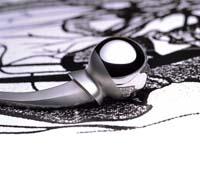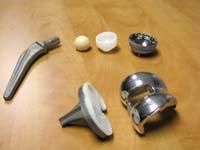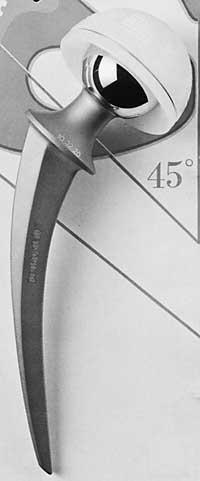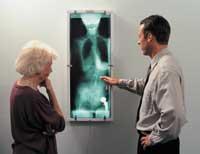Artificial hips and knees
2010/07/01 Kortabitarte Egiguren, Irati - Elhuyar Zientzia Iturria: Elhuyar aldizkaria

When hip or knee pain is unbearable and that pain alters life and quality of life, the best solution is to place a prosthesis. Although there are joint prostheses of the body, the most implanted are hip and knee prostheses. This is one of the most common surgical interventions in ACBC, the third. Every year 35,000 hip and knee prostheses are implanted in the ACBC, as the only solution in many cases to eliminate pain and recover joint mobility.
It is not surprising that the hip and knees suffer numerous injuries, joints that allow us to walk, run, bend and perform other usual activities, in addition to maintaining the weight of the whole body. "Therefore, if the joint is eroded (as in the case of osteoarthritis), it is recommended that it be completely replaced by a prosthesis," explains Jaime Usabiaga, director of the Orthopedic Surgery and Traumatology Service at Donostia Hospital and professor of Orthopedic Surgery and Traumatology at UPV.
Although prostheses have been increasingly accepted in recent years and their use has spread, this does not disregard the concerns that patients may have with such an operation: "How long does my prosthesis last? ", "Is it going to give me problems? ". These kinds of questions are used to doctors. To respond to all of them, experts rely on previous experiences. Predicting the duration of the prosthesis is not an easy task. The problem with prostheses is that little can be done in test benches. "In short, in patients it is proven how long a prosthesis will last, whether it will work or not, etc. There are no animal models of prosthesis research, among other things because there are no two-legged animals. The most human-like animal is the monkey, and yet it is not used for prosthetic testing, as it often uses hands. So both the hips and knees do not bear the same load," explains Usabiaga.
Predicting the response to the prosthesis of one person or another is virtually impossible. So they try to make it clear to patients that the prosthesis can fail. Problems can arise from the first moment of implantation of the prosthesis. The first immediate problem, which may appear in the first few weeks, is infection. "The infection rate is about 1%, that is, 1% of the hip and knee prosthesis that we implanted is infected," explains Usabiaga. The second immediate problem is embolism. Therefore, before the intervention patients are subjected to a preventive treatment of embolism to reduce the risks of thinning blood and embolism. There are also problems that appear later, such as late infection and relaxation of the prosthesis. "The moment the prosthesis moves, it behaves like a sandpaper, making a hole in the bone. That's very painful."
To avoid or reduce the problems that prosthesis can cause, experts work in different fields: On the one hand, they prevent the main problems: infections and embolisms. On the other hand, we are working in the field of materials, that is, in the research of new materials to overcome these problems and extend the survival of the prosthesis.
Material Sauce

Dr. Usabiaga has been working for years in the field of prostheses and, in view of the history of prostheses, states that eleven types of materials have been used in its development: "glass, aluminum, ivory... But the raw materials were of low quality and many prostheses failed."
In current prostheses, the root of the prosthesis is almost always metallic. Titanium predominates among metals, especially in the case of hip prosthesis, since its elasticity is similar to that of bone. However, chromium-cobalt alloys are also used, among others. In addition, in some cases, these metals or alloys are coated with hydroxyapatite ore to improve fixation between metal and bone. In the case of knee prostheses, however, they do not use titanium but steel or their alloys. "In fact, they have seen in several experiments that titanium breaks. It may break because it's so elastic."
The hip joint involves two bones: the femur and pelvis. The head of the femur is a kind of sphere or ball that enters the hole or hole that has the pelvis for it. The procedure involves removing the head of the femur and inserting the prosthesis root into the femur. The head of the femur is replaced by a metal, ceramic or plastic ball. They also add a kind of hat to the pelvis. This hat or cap can be metallic, ceramic or plastic. The friction between these two components --bole-hat - has generated over the years numerous problems that still generates and whose objective is to correct them, reducing as much as possible the wear that can occur between both components.
In these two elements or components four pairs are mainly used: metal/metal, plastic/metal, plastic/ceramic and ceramic/ceramic. Of these four models, metal/metal is a combination that many research again and can have a promising future. "I've known two metal/metal attempts that have failed. This is the third attempt and we will see what happens," explained Usabiaga. "In the US, for example, this couple or combination is prohibited to women of reproductive age. It is not clear that some particles do not pass into the blood and cannot cause problems in the fetuses of pregnant women," he added.
In fact, one of the current novelties is the replacement coating prosthesis formed by the metal-metal pair. "They are prostheses designed for young people and one of their characteristics is that their first modification is greatly simplified," explains Usabiaga. "On the contrary, their disadvantage is that in the short term they give more problems, since they are more difficult to implement than conventional hip prostheses. In fact, the minor error that can be made during surgical intervention during the implantation of the prosthesis is also problematic. If we overcome them, they have a promising future," says the doctor.

However, this pair is not the only combination of researchers, and many researchers agree that the ceramic/ceramic combination can ensure the best friction between its components. It is a resistant material that releases few particles, but at the same time fragile, being able to crack or crack in case of blow.
The recent doctoral thesis published by the San Sebastian engineer Nere Garmendia can help solve this problem. Garmendia wanted to demonstrate that ceramic prostheses can be prevented from cracking. For this purpose it has added carbon nanotubes to a matrix or circus base to increase its hardness. "The key is working on the nanoscale," says Garmendia. In his experiments with the circus he concluded that in 12 years this material is very obsolete. "The use of carbon nanotubes and circus nanoparticles, in addition to the circus matrix, does not allow aging for more than 30 years," he added.
Plastics or polyethylene, on the other hand, are easier to erode, but having the ability to cushion shocks, they are less easy to break. "Without a doubt, every material has its advantages and drawbacks," explains Usabiaga.
With or without cement
Another important aspect is to attach the prosthesis to the bone. One option is to use cement. The English traumatologist John Charnley pioneered the use of cement in his prosthesis. The English traumatologist implanted one of the first permanent hip prostheses in the late 1950s and early 1960s. "These prostheses stuck to the bone with cement and often caused damage, not the prosthesis itself. Because of erosion, it is possible that the cement releases several particles, and that these foreign particles to the body can form an inflammation or relax the prosthesis itself," explains Usabiaga.

"The cement immediately sticks the prosthesis to the bone. It can be said that the patient leaves the operating room with the prosthesis attached to the bone. In theory, the next day the patient is able to walk. However, when we fix the prosthesis without cement, it takes the bone to adhere properly to the prosthesis," he added.
Decreased use of cement. However, there are still cases in which bone use is mandatory for medical personnel, among other things when bone is of low quality.
"Fixation and friction are two essential elements of a prosthesis with or without cement. That is, the fixation of the elements that stick to the bone must be durable and the materials should not wear out in the friction between the head and the hat", stressed Usabiaga. The prosthesis that is not separated from the bone and that is not eroded would be eternal and, logically, is what all doctors and researchers experts in the field intend.

Gai honi buruzko eduki gehiago
Elhuyarrek garatutako teknologia






